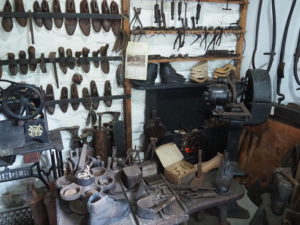Leaving the reception area, the first part of the museum recreates a typical village scene with shops and workshops.
A hundred years ago, small villages were self supporting units with a wide range of shops, workshops and craftsmen, supplying all needs. The museum has a selection of small workshops that would have been common in many villages 150 years ago.
The BLACKSMITH was was the most important craftsman in the community, and every village had one. Nearly all the other trades depended upon him. As well as shoeing horses he made and repaired farm machinery as well as putting metal rims on wagon wheels and as making tools for other craftsmen.
The WHEELWRIGHT often had his workshop close to the blacksmith as the blacksmith was responsible for fitting the iron tyre on the wheel. As well as making wheels for carts and wagons, the wheelwright also repaired many farm tools.
There has been a long history of IRON FOUNDRIES in Ryedale from the 1800s. Many began by making agricultural implements or small steam engines or pumps for use on the farm. Later, many diversified into items for domestic use like kitchen ranges, cast iron grates, doorstops and other decorative work. The ore was melted in a small furnace before being poured into moulds.
TINSMITHS worked with tin or other light metals that could be cut and shaped without needing to be heated. They produced a wide range of cheap kitchen utensils including jugs, plates, bowls and lanterns. As well as working from a workshop, many were itinerant, travelling around the country repairing household, dairy and other containers.
A SHOEMAKER had been common in all villages before the mass production of shoes in factories. Not only did they make shoes, they also made wooden soled clogs which were popular with farm workers and those working in factories. Many worked from a small workshop in yard. By the First World War, many local shoemakers were only working as cobblers repairing commercially made shoes.
The SADDLER used many tools similar to the shoemaker as they both worked in leather. Originally they would have made saddles and harness, but later they had catalogues with ready made riding saddles and other goods which could be chosen by the customer.
Repair work was an important part of the craft and would range from blacksmith bellows to drive belts for farm machinery. They would also repair small household items like suitcases or hat boxes.
The COOPER also made other household items like buckets for water or milk, washing bowls and dolly tubs for the laundry and a variety of smaller wooden jugs and bowls. Up until the C20th many foodstuffs and other commodities were transported in wooden casks. This was a very skilled work and required a four year apprenticeship.
There is also a reconstruction of the stone base of an illegal GLASS MAKING FURNACE which was found in Rosedale. In the Elizabethan period, glass was expensive and difficult to manufacture. The government exercised tight control over who could make glass by issuing a special license. Not many of these licenses were issued, so many glass makers operated illegally. Ryedale was a good choice as it had clay to make the crucibles, fuel from the surrounding forests and silica from local sandstone rocks, and lime. Bracken was burnt to make alkali, which helped the sand to melt. This gave a distinctive green colour to the glass, which was known as forest glass.
Glass making finished suddenly at the end of the C17th. Different suggestions have been put forward, but no-one really knows why.
There are lots more pictures “here.”:https://www.sloweurope.com/community/threads/hutton-le-hole-and-the-ryedale-folk-museum.5978/










